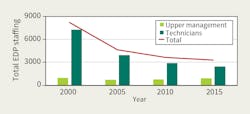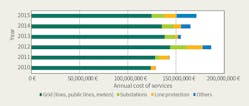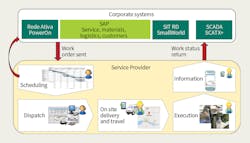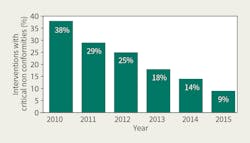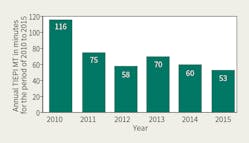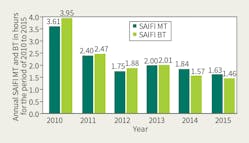As with other utilities, EDP Distribuição’s efficiency and competitiveness have a direct correlation to the performance of its assets. Therefore, quality control is critical to ensure the assets continue to perform throughout their operational life in accordance with the design specifications.
Currently, a high level of outsourcing occurs in the electricity industry for construction, maintenance and service activities. This trend has resulted in quality-of-service indicators to conform with regulatory and market requirements. An ongoing challenge for utilities is determining the right hiring strategy and control models to meet the required high standards. EDP addressed this problem by establishing a quality assurance strategy that has resulted in improving the efficiency of its outsourced activities.
The Outsource Shift
As the demand for energy and number of customers were increasing, major regulatory changes were taking place in the electricity sector in Portugal that demanded an efficient response from EDP, the Portuguese distribution system operator, to control costs. The only available solution was to outsource activities. By 2010, almost all construction and maintenance activities on the distribution network were performed by contractors. These activities included work on high-voltage (HV), medium-voltage (MV) and low-voltage (LV) networks, streetlighting, substations, meter installations and customer assistance.
As a result of the decision to outsource, the utility’s remaining employees took more managerial roles. EDP now had an opportunity to review its management of the engineering sector, which ultimately led to improved resource management and a greater capacity to respond to growing market demands.
Quality Assurance Strategy
Currently, EDP invests €100 million annually (US$119 million annually) on equipment and materials, and the outsourcing expenditure averages €150 million annually (US$179 million annually) through centrally negotiated long-term contracts.
EDP’s model contract consists of three key processes: supplier qualification, purchase and award, and contract execution. The utility has several primary contracts based on the volume of work and scope of activities. These generally are turnkey contracts awarded for periods ranging from three years to five years, but shorter periods are used for small-volume work contracts. The most important contracts are for network construction and maintenance.
As it is not possible to define a model for all construction and maintenance processes, it is essential to ensure a supplier applying for such contracts has a proven level of performance compatible with EDP’s standards.
Prior to the award of contracts, all contractors are subjected to a selection and qualification process whereby the suppliers must fulfill the following requirements:
• Meet and satisfy all legal and financial obligations as well as hold the required certifications.
• Be structured with an adequate technical management capacity.
• Have equipment, vehicles and sufficient technically qualified resources to perform the complete range of activities.
These requirements have promoted a continuous improvement philosophy that extends throughout the supply chain (contractors, subcontractors, technicians and managers), improving results and positively influencing the quality of execution.
Purchase and Award
To simplify the allocation of contracts, EDP divided the country into 19 geographical zones. Following negotiation, contracts are awarded to a single contractor for each zone, and the contractor is responsible for executing the full range of activities. The contractor in each zone is subject to the same policies, terms and conditions. EDP differentiates between contracts for distribution and primary substation works, with separate rules for substation civil and electrical works. As these works are completely different, they attract specialized contractors, resulting in highly qualified craftsmen at a cost savings. The overall objective is the same for all zones apart from a few service-level agreement variations in the minimum benchmarks required by EDP for each zone.
The results and performance evaluation model is the same for all contracts and based on established criteria, which is reviewed, measured and made known to the contractors periodically. Deviations from EDP standards are subject to incentives and penalties.
All services provided by contractors are assigned a reference price. Staff members responsible for the budget in a given geographical area use an enterprise software interface that assigns the necessary activities for the model as well as the man-hours and materials needed for each activity. In practice, this methodology enables the daily award and dispatch of some €500,000 (US$595,000). This system has additional functionalities such as the definition and control of execution times, registration of changes to the initial budget, material transport guides and self-billing.
Contract Execution
The key factor for good performance is the quality and control of labor resources. EDP has an accreditation process to store information on contractor and subcontractor employees in terms of function, qualification and training. The database has a web interface that authorized entities can access.
Each contractor’s execution performance is evaluated on the job by a systematic series of audits by EDP’s appointed standards officers.
Quality Audits
National contracts enable EDP to standardize its processes and systems. Thus, it is possible to control the execution of activities through audits. EDP has a centralized audit department that has no connection to the internal organizations responsible for a contractor’s activities. Eight engineers in the audit department are staffed in two geographical centers, which, at present, are sufficient for auditing all nationwide activities.
Audits are conducted on a random basis to provide a statistically representative sample and divided into two types:
• Audits on work in progress (during execution).
• Audits on completed works (after completion).
The in-progress audit focuses on the technical execution of the process, safety and environmental issues, while the survey of completed works is centred on compliance with technical and budgetary standards.
Performing audits during the work in progress provides the opportunity to eliminate nonconformity before the installation is commissioned, thereby eliminating the need for future intervention. Ultimately, this increases asset performance and efficiency. Check sheets are used for each type of intervention activity, and the data collected in the audit feeds a report listing nonconformities. Resolution requiring situations, improvement areas and evaluation also are recorded in these reports.
The results of this information-gathering process are shared with the contractors to promote future good practice. The knowledge database is of vital importance for the implementation of nonconformity mitigation measures, namely in the form of awareness actions, workshops, procedure updates and specification revisions. Each contract has enabled EDP to learn, improve, and help to adapt its employees and contractors to develop a real partnership, which has resulted in the utility focusing on partnership management.
As a result of the impact of the audit procedures on the performance of EDP and its contractors, it is crucial to have reliable, optimized processes with results and monitored quality indicators, which are currently guaranteed by ISO 9001 (Quality Management Systems Certification).
The tender documentation includes all the contract evaluation criteria. So, all partial evaluations obtained in the audits contribute to the achievement objectives (service level agreement) as well as the system of incentives and financial penalties.
Strong Results
EDP’s quality assurance strategy has promoted improvements in contractor quality, which is evident in the evolution of the evaluation indicators. Since 2010, the number of recorded interventions with critical nonconformities has decreased by 75% in five years.
Also, by analyzing the areas of below-acceptable performance from the 2010 audit reports, an action plan was established that included training sessions, reviewing evaluation criteria and updating technical documentation. In particular, this involved contractors and organizational units in EDP to reduce the number of nonconformities in ground/earthing connections. By 2015, the percentage of nonconformities was reduced from 20% to 5%.
The quality assurance of the various phases and interventions of asset construction also has contributed to significant improvements in the installed capacity equivalent interruption time (TIEPI), system average interruption frequency index (SAIFI) and system average interruption duration index (SAIDI).
The results indicate the implemented methodologies promote the efficiency of EDP’s operations. The audits have promoted and facilitated the information flow to all stakeholders, reinforcing existing partnerships and fostering good relationships.
Auditing is a process of contract and standards self-regulation in which the information gathering that occurs makes it possible to identify the need for new tasks as well as update existing activities and work methods, enabling higher levels of performance to be achieved.
Establishing service quality objectives and periodically evaluating them promotes continuous improvement. Controlled outsourcing as a utility strategy enables tasks to be outsourced without losing the know-how in-house while retaining execution control.
Future Challenges
EDP is committed to implementing improvements to its audits that will lead to an increase in their effectiveness. It will be necessary to extend the functionality of the mobility tools to all types of work—as it currently is limited to customer service and fault recovery processes—to know in real time the location of the service provider’s teams, ongoing activities, technical performers and so forth.
It is fundamental to create methodologies that ensure the maintenance of internal knowledge to avoid relationships of exaggerated and irreversible dependencies on the market.
Alternatively, there are new challenges to the sustainability of outsourcing related to ethics compliance, labor relations, social responsibility, and rights and obligations of employers and employees. Predictably, these aspects will be on the agenda of the entire supply chain, and audit activity will be able to integrate new areas of intervention.

